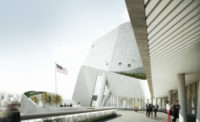A Tale of Two Stations

Riding Amtrak from Washington’s Union Station to New York’s Penn Station is a trip, architecturally speaking, from heaven to hell. So it came as a surprise this summer when Amtrak announced plans to transform one of those stations into “a world class transportation hub,” at an estimated cost of nearly $7 billion. The upgrades will bring a vast new, glass-roofed train shed by HOK and Parsons Brinkerhoff to—wait for it—Washington’s Union Station, a Daniel Burnham-designed showplace. At the same time, plans for replacing New York’s Penn Station, the famously disgraceful hole under Madison Square Garden, with a more respectable facility in the Farley Post Office building on the West Side of Eighth Avenue—first proposed by Senator Daniel Patrick Moynihan in 1993—are in limbo.
 |
| Image courtesy Amtrak A section of Amtrak's plan for a nearly $7-billion redevelopment of D.C.'s Union Station |
True, there is some good news in New York. In May, the non-profit Moynihan Station Development Corporation awarded a $148 million contract to the construction giant Skanska to create street entrances to an existing concourse under the steps of the post office (the concourse is now accessible only through subway passageways). The improved West End Concourse could, someday, be a small component of the long-hoped-for Moynihan Station. But the station itself, once designed by David Childs of Skidmore, Owings and Merrill with a luminous ticketing hall in the courtyard of the old post office building, is still on hold. Amtrak, which would be the lead tenant, is at the mercy of two large developers, Vornado Realty Trust and the Related Companies, which have an option to develop parts of the Farley site, but haven’t found just the right money-making formula. (At one point last year, Vornado offered to build the Borough of Manhattan Community College a campus inside the post office building in exchange for the school’s valuable land in the pricy TriBeCa neighborhood.)
Things are a lot less complicated in Washington. There, the developer Akridge purchased the air rights over Union Station’s train yard from the federal government. That allows Akridge (whose civic-minded CEO Chip Akridge is the force behind the Trust for the National Mall) to move forward with Burnham Place, a 3 million square-foot mixed use development, designed by Shalom Baranes Architects, that would fund the improvements to the station. Burnham Place is named for Union Station’s architect.
In New York, SOM is still the Moynihan Station architect, and according to Mark Regulinski, SOM’s partner in charge of the project, the firm is proud to have stayed in the game through numerous changes of client and program. (At one point, Related and Vornado were working with HOK and James Carpenter on their own plan for the station.) Regulinski said Childs, 71, is consulted regularly on the project, but that “there isn’t a lot of design work involved right now.”
Still, Regulinski says, the renovation of the West End Concourse was something the private developers-were reluctant to take on. Now that the federal and state governments are footing the bill for what he calls a “gnarly” job, there is a higher likelihood that developers will want to move forward with the profit-making portions of the development. But even moving Amtrak’s operations to a new Moynihan Station wouldn’t help 90 percent of the commuters who use Penn Station every day (patrons of New Jersey Transit and the Long Island Rail Road, which would remain under Madison Square Garden on the east side of Eighth Avenue). The only way to create a new train station on that site would be to move the Garden—and right now, the Dolan family, owners of the arena, are happy where they are. (Indeed, they have just spent $980 on a renovation that will be unveiled in November.) Meanwhile, the Metropolitan Transportation Authority (yet another stakeholder) has hired the Los Angeles office of AECOM to undertake a $7.7 million study of ways of making the existing Pennsylvania Station less ghastly—called Penn Station Vision—a strong sign that the station won’t be replaced anytime soon.
Amtrak officials wisely didn’t mention the Union Station project during a gala dinner at the Farley Post Office on May 8. The event was meant to shine a spotlight on plans for Moynihan Station. While train aficionado (and actress) Rosario Dawson spoke to journalists, who were fed a dinner created by Amtrak’s consulting chefs, images of the planned Moynihan Station were projected onto screens hung in the old post office. (The current SOM scheme replaces the glass-ceilinged ticketing hall with a more modest design that reuses the building’s existing steel trusses.) SOM’s Regulinski was at the event, but he wasn’t asked to speak. Later, he told a reporter that he didn’t mind the slight: In nearly 20 years on the Moynihan project, Regulinski said, "We've learned to be modest."



